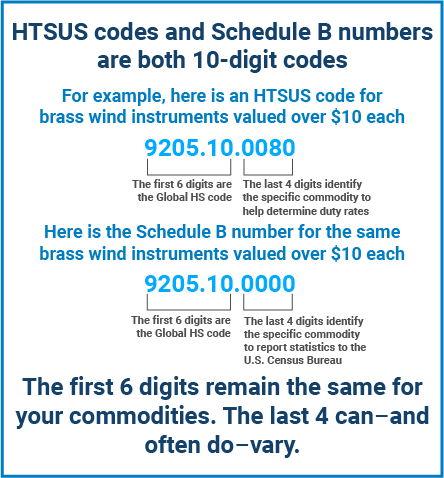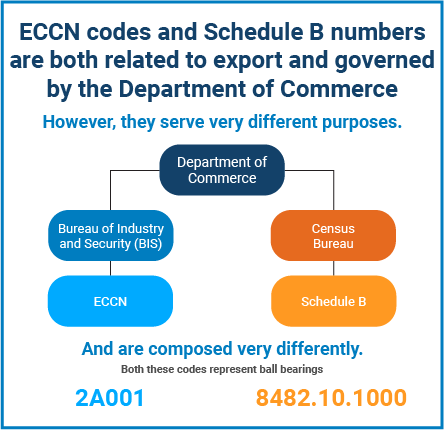Understanding Schedule-B Classification
What is a Schedule-B Number?
The international Harmonized System (HS) is administered by the World Customs Organization (WCO) and serves as the foundation for both import/export classification systems. A Schedule-B is a U.S.-specific classification code for exporting goods from the United States. It is administered by the Census Bureau’s Foreign Trade Division, which keeps records of exports by country as well as the quantity and value in U.S. dollars. The Schedule-B is built upon the first 6-digits of the HS code, and an additional 4-digits for statistical analysis. To summarize:
- Chapters – the first 2-digit numbers
- Headings – These build upon the Chapter codes by two, creating 4-digit numbers
- Subheadings – Builds on the Chapter and Headings codes with an additional two digits, creating the 6-digit number
- Country-specific Information - The U.S. requires additional information for exports including data on national tariff rates and commodity codes used for statistical analysis.
What is the Difference between an HTSUS and a Schedule-B?
It’s important to understand that HTSUS numbers and Schedule-B numbers have separate functions and should not be used interchangeably. While the Harmonized Tariff System of the United States (HTSUS) facilitates efficiency in international trade, Schedule-B codes are primarily used to provide analytical data to the U.S. government in monitoring exports. The origin of each of the codes derives from separate governing authorities, although both are parts of the HTSUS code and required for the successful exportation of goods from the U.S.

What is the Difference between Schedule-Bs and ECCNs?
An Export Control Classification Number (ECCN) is generally applied if an exported good is housed on a controlled list such as the U.S. Commerce Control List (CCL). An ECCN often applies to dual-use items for the purposes of export control from the U.S. This 5-digit designation differs in purpose from the scope of a Schedule-B number. Most ECCNs require a license for export, which includes a fraction of the items exported or re-exported from the United States.

How Does a Schedule-B Number Relate to AESDirect?
Schedule-B numbers are generally required to be reported in the Automated Export System (AES) for shipments valued at more than $2,500 or when an export license is used. The code must be included for use in the AESDirect system now part of the Automated Commercial Environment (ACE) and is essential to the receipt of an Internal Transaction Number (ITN). AESDirect is a system that essentially notifies the U.S. government that certain commodities are leaving its borders and helps to transmit Electronic Export Information (EEI) details one-at-a-time to comply with export regulations.
Do Other Countries Have Separate Classification Systems for Imports & Exports?
In addition to the U.S., other countries also maintain several tariff schedules for imports and exports. As mentioned, the U.S. enables two databases for the purposes of imports and exports. The Australian Harmonized Export Commodity Classification (AHECC) can be compared to Schedule-Bs/ECCNs and is used for export classifications from the country. Additional counties with two systems of record include: Canada, the European Union (EU), India, Japan, Pakistan and Papua New Guinea.
Schedule-B Software to Speed the Flow of Exports
Designed to help minimize those trade barriers, Descartes’ Schedule-B Software draws from a vast database of data relating to regulations, rulings and duties. With Descartes' solution in place, businesses can effectively automate certain processes that can result in significant increases in productivity, improved compliance and decreased costs related to Customs classification, compliance and trade data management.
Multi-national shippers, customs brokers, Third-party Logistics Providers (3PLs), freight forwarders, carriers, compliance professionals and others use Descartes CustomsInfo™ to help build and maintain complex classification databases, making global operations more streamlined and efficient.
For more information, register to download a comprehensive eBook including best practices to better manage Schedule-B information, duties, taxes, and more.
